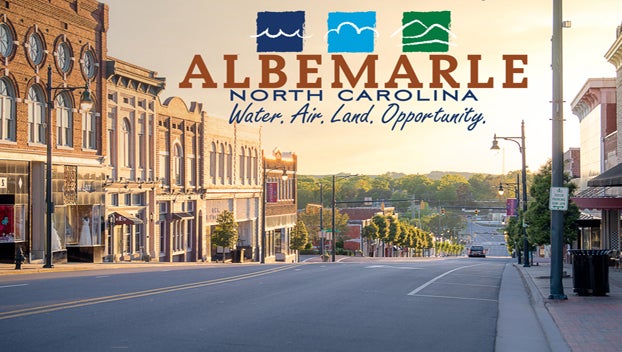Residents provide feedback, voice concerns about Albemarle’s new stormwater program
Published 3:11 pm Thursday, April 14, 2022
|
Getting your Trinity Audio player ready...
|
About 30 people came out Wednesday evening to voice their opinions and concerns regarding the new stormwater plan Albemarle staff is developing and planning to include as part of its 2022-2023 budget.
The public forum, which was inside council chambers at City Hall, provided the opportunity for people to learn more about the program and ask questions of officials with WK Dickson, a Charlotte-based community infrastructure consulting firm, and Raftelis, a Charlotte-based management consulting firm, who have been working with council and city staff to implement the program.
WK Dickson has spent much of the last year conducting a comprehensive stormwater management study which has included engaging with the public to learn what areas are most at risk to flooding, evaluating the city’s outdated stormwater infrastructure and analyzing how much a new program would cost.
About the stormwater program
In a short presentation before the question and answer portion, Tom Murray, stormwater program manager with WK Dickson, explained it would cost the city about $2.5 million annually to properly manage the stormwater program. This includes about one million for operation and maintenance and $540,000 for capital investment.
The city would also bolster the stormwater program by adding several new employees, who would be part of the public works department, to focus solely on the stormwater program. These include a stormwater manager, administrator and technician along with multiple maintenance crew members.
To support the stormwater management program, residents of the city would pay a stormwater utility fee of $11.50 per month. They would see a slight decrease in their solid waste fee as leaf collection would be included in the stormwater program.
The funds would be used for purposes such as repairing and replacing deteriorating stormwater pipes, identifying and implementing capital projects and meeting potential state and federal regulatory requirements.
The plan is for residents to be billed based upon Equivalent Residential Units (ERUs), which is the amount of impervious surface area on properties within the city. A typical single family residential property has 3,270 square feet of impervious area, which amounts to one ERU — the baseline from which other city properties will be evaluated.
So if a property had roughly 9,300 square feet of impervious surface, that would be about three ERUs (9,300 divided by 3,270). Multiplied by $11.50, the monthly stormwater rate would be $33.
The tentative plan moving forward is to have another public forum on May 11 before the council, in all likelihood, adopts the stormwater plan during its June 6 meeting. Rates for the new stormwater utility fee would begin to appear on residents’ monthly bills in July.
Addressing citizens’ concerns
One of the first questions that came up was how the capital projects, such as creek and stream restoration, would be prioritized once the program is adopted.
Tom Murray, with WK Dickson, mentioned that the selection of projects will be largely based on location, severity of the flooding and how many people tend to be impacted.
“So if you have a significant city street that gets flooded on a regular basis and that has a high traffic count, that would certainly rank high,” Murray said. “If you have structural flooding that is impacting the homes or business that is causing significant damage, those projects typically will be ranked higher.”
In consultation with WK Dickson, staff will develop a city-wide Water Resources Master Plan to identify, select and prioritize capital projects as needed to help residents struggling with flooding issues. There will be a “defined process” for improving each watershed that will be publicly available so residents can see what projects the city is prioritizing. A pilot watershed study is underway to assess the conditions of the Melchor Branch stream.
Another resident, who said he owned industrial property in the city, was concerned about how much certain property owners would have to pay each month, especially those with large areas of land. A business with 200,000 square feet of impervious surface, for example, would have to pay about $700 a month for stormwater, in addition to the other utilities.
Katie Cromwell with Raftelis mentioned that the amount of impervious surface on a property “closely correlates” to the owner’s demand for stormwater service.
“So really the most equitable way to pay for it and fund stormwater is through basing the fee off of impervious area,” she said.
When a question was raised about what to do with state-maintained roadways such as N.C. Highway 24-27 and N.C. Highway 740, Murray mentioned that in many other communities managing stormwater, there is a partnership between NCDOT and local officials.
“We certainly want DOT and need to work with them collaboratively to maintain their system,” Murray said, “and so by having a crew dedicated to stormwater maintenance, it’s something that when we see issues within the DOT right-of-way, we can make them aware of them in a timely fashion.”
There also appeared to be confusion among some residents about how separate the stormwater program would be from sewer, or if the two even needed to be divided. Once adopted by council, stormwater would be an independent utility similar to that of water, sewer and electric. Though it would be a new concept for Albemarle, more than 80 cities across North Carolina already have established stormwater utilities.
“A stormwater utility is a stormwater system — pipes in the ground, ditches, creeks, streams, culverts — and it’s no different than a water system, no different than a sewer system, no different than electrical system,” said public works director Ross Holshouser. “The thing that Albemarle is trying to do, we’re going to try to fund our stormwater system the same way we fund our other systems — it is a utility.”
Having a specific stormwater program in place, which includes mapping of the existing infrastructure, would make it easier for staff to assist residents during periods of intense rainfall — something that has been difficult in the past.
Whenever his team gets called to help during periods of flooding, Holshouser said, “we don’t know where pipes are in the ground, we don’t have a mapping system for stormwater. So we are flying by the seat of our pants when we get called out to try and navigate and fix public issues when there’s flooding in the streets.”
This new system, though it will take time to implement, should prevent many of those problems, staff said.
“It didn’t get this way overnight and it’s not going to be a quick fix overnight once it’s implemented, but at least it’s going to get us set up to move Albemarle forward,” Holshouser said.







